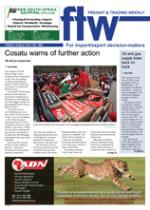The Port of Cape Town may
have received a relatively
small share of the investment
budget for the ports over
the next seven years, but
it remains a priority in the
Transnet stable.
According to Francois
Meyer, executive manager:
planning integration with
Transnet, the allocation of the
seven-year budget per port
shows Durban receiving 36%
of the total money at R28bn.
“This is mainly allocated
to container expansion in
the port, and includes land
acquisition for the new
dig-out port. Ngqura and
Richards Bay each get R18bn,
largely for expansion in bulk
capacity. Cape Town receives
a relatively small share at
R3.2bn.”
Meyer said despite the
allocation of money, seaward
expansion plans of Cape
Town Container Terminal
to balance landside and
waterside capacity were
unlikely to go ahead – and
nor were plans to increase
landside container handling
areas.
“The port is South Africa’s
oldest port and is not as
competitive as some of the
other ports in the country.
While the Cape Corridor
does fulfil the three major
roles of a corridor – which
are to connect domestic
producers with consumers,
connect the distant hinterland
with international products,
producers and markets,
and to transport people it is
not a competitive gateway
corridor.”
But, said Meyer, while
the Cape Town port was
not in the same league as its
big brothers in Durban and
Richards Bay, it did play a
crucial role in the country’s
port stable.
“There is a lot of
development that is
happening to ensure the port
can handle the new generation
vessels – despite competing
on a recreational, residential
and commercial front for
space,” said Meyer. “There
is revamping happening
at the port in an effort to
reconfigure some of the areas
and deepen the berths.”
He said a study was also
under way to determine the
impact of a new breakwater
and outer basin that could
see capacity drastically
increased.
He said the port also
played an important role as it
was the gateway to the Cape
Corridor. “For us it is about
three criteria – how many
tons you have, what type of
commodity you want to move
and how far it must go.”
He said distances
greater than 300km were
very attractive for rail
depending on the volume and
commodity type. “There are
many opportunities for rail on
this corridor. At the moment
we are doing hardly any of
the rail-friendly cargo that is
out there – so the potential is
there, but we need to get the
infrastructure in place and
significantly increase our
mobile market share to up
our game.”
Cape Town port gears up for next-generation vessels
16 Mar 2012 - by Liesl Venter
0 Comments
FTW - 16 Mar 12

16 Mar 2012
16 Mar 2012
16 Mar 2012
16 Mar 2012
16 Mar 2012
16 Mar 2012
16 Mar 2012
16 Mar 2012
16 Mar 2012
16 Mar 2012
Border Beat
Featured Jobs
New
New
